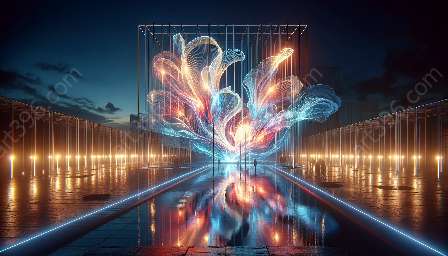Light graffiti art, also known as light art, has emerged as a captivating and transformative form of artistic expression that has the potential to profoundly impact architecture and urban design. This innovative art form utilizes light as its primary medium, creating ephemeral and evocative visual spectacles that have the power to redefine and enhance built environments, cityscapes, and cultural landscapes.
The Transformative Effects of Light Art
Light graffiti art employs various light sources, such as LED lights, laser beams, and projections, to create luminous compositions that interact with architectural elements, façades, and public spaces. These dynamic visual interventions can imbue structures with a sense of vitality and movement, transforming static buildings into dynamic canvases that engage and captivate viewers.
The transformative effects of light art on architecture and urban design are multifaceted. Light graffiti art has the ability to redefine spatial perceptions, alter visual experiences, and create immersive atmospheres within urban environments. By altering the nocturnal appearance of buildings and public spaces, light art can elicit a sense of wonder and enchantment, revitalizing the urban landscape after dark and fostering a unique sense of place.
Enhancing Architectural Features and Urban Dynamics
Light art possesses the capacity to accentuate architectural features, accentuating the form, texture, and details of buildings in ways that conventional static art forms cannot. By selectively illuminating architectural elements, such as columns, arches, and facades, light graffiti art can highlight the inherent beauty and character of built structures, creating a new dialogue between art and architecture.
Furthermore, the integration of light art into urban design can contribute to the creation of dynamic and interactive cityscapes. Installations of light graffiti art can serve as focal points within public spaces, intensifying the sensory experience of urban environments and fostering social interaction. By activating neglected or underutilized areas, light art can contribute to the revitalization and reimagining of urban landscapes, fostering a sense of community and cultural vibrancy.
Urban Regeneration and Cultural Identity
Light graffiti art has the potential to play a pivotal role in urban regeneration and cultural identity. By breathing new life into overlooked or derelict spaces, light art installations can act as catalysts for urban renewal, promoting a sense of pride and ownership within local communities. The integration of light art into public spaces and architectural projects can serve as a reflection of the unique cultural identity and heritage of a city, enriching the visual and experiential fabric of the urban environment.
Moreover, the ephemeral nature of light graffiti art fosters a sense of temporality and impermanence, prompting contemplation of the transient nature of urban landscapes and architectural spaces. This transient quality encourages viewers to engage with their surroundings in new and meaningful ways, prompting a reevaluation of the relationship between art, architecture, and the built environment.
Collaborative Opportunities and Technological Advancements
Light graffiti art presents opportunities for collaborative ventures between artists, architects, and urban designers, leading to cross-disciplinary projects that meld artistic innovation with architectural ingenuity. The fusion of light art and architecture requires a deep understanding of materials, technology, and spatial design, fostering new modes of creative collaboration that transcend traditional artistic boundaries.
Furthermore, advancements in lighting technology and interactive media have expanded the creative possibilities of light graffiti art, enabling the development of interactive and responsive installations that invite viewer participation and engagement. These technological advancements have the potential to redefine the relationship between art, architecture, and the public realm, creating immersive experiences that blur the boundaries between the physical and digital worlds.
Fostering Dialogue and Public Engagement
Light graffiti art has the capacity to initiate a dialogue between artists, designers, and the public, catalyzing discussions about the role of art in shaping the urban environment. By activating public spaces with temporary light installations, light art can ignite public curiosity and foster a sense of wonder, prompting engagement with the built environment in novel and unexpected ways.
Moreover, light graffiti art has the potential to serve as a platform for addressing social, cultural, and environmental issues within the urban context. Through the creation of site-specific light installations, artists and designers can communicate narratives that reflect the cultural, historical, and ecological significance of architectural and urban spaces, fostering a deeper appreciation for the interconnectedness of art, architecture, and the urban fabric.
Conclusion
In conclusion, the impact of light graffiti art on architecture and urban design is profound and multifaceted, encompassing aesthetic, cultural, and experiential dimensions. As a dynamic and transformative art form, light art has the potential to redefine spatial perceptions, accentuate architectural features, and contribute to the regeneration of urban landscapes. By fostering dialogue, public engagement, and interdisciplinary collaboration, light graffiti art can play a pivotal role in shaping the future of architecture and urban design, enriching the built environment with ephemeral moments of luminous beauty and artistic expression.

